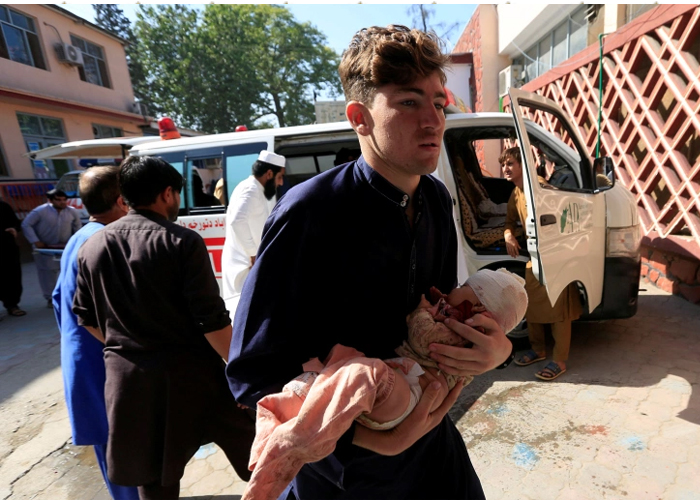Civilian deaths are the most heinous outcomes of the circumstances wherein insecurity, terrorism and conflicts thrive. Mostly, in the most horrific way, people who are not in any way connected to the war, lose their lives , though they should have the right to life as their basic human right. And, the state has the responsibility to ensure that the citizens are granted that right without any trouble. Sadly, there are many states in the world that have not been able to provide their citizens with that right; and, Afghanistan is one of the same states. The poor masses in Afghanistan keep on worrying about the deterioration in security, since they are essentially those who have suffered and will suffer the worst consequences of insecurity and violence. Seeing people lose their lives when they have nothing to do with the war is truly tragic. People have not only endured the hardships of impoverished and wretched lives, but also the horrors of war in an economically fragile and war -torn country like Afghanistan .
As if people ’s lives have no worth or sense, they are mercilessly killed and there is no justice in Afghanistan that can hold the perpetrators accountable for the killings. Therefore, the killings have continued, and keep on rising in certain situations, mostly when the fighting factions want to dominate the opponents. In the last few months, the killings have increased again, as the intra-Afghan talks have started, and the involved factions want to dominate in the fighting field to gain upper hand in the next round of talks .
On Monday (Dec. 28, 2020) International Committee of the Red Cross (ICRC) said in a tweet that Afghanistan is one of the deadliest countries for the civilians. It estimated that 50 percent of the country ’s population (around 17 million people) live somewhere in the country that is highly influenced by armed conflict. This number is alarmingly high and show the nature of insecurity that the people face in the country .
The New York Times ’ Afghan War Casualty Report for the month of December (Dec. 01 to Dec 25) reveals that 93 civilians have been killed in Afghanistan during the period. The deadliest attack during the period took place in Ghazni province, where 15 civilians were killed after unexploded ammunition detonated. Whereas another attack in Kabul on Khan Mohammad Wardak ’s convoy killed 10 civilians and wounded around 52 others .
The New York Times ’ report for the month of November shows that around 200 civilians were killed during the month. However, Action on Armed Violence (AOAV) said in a report that Afghanistan was the country worst impacted by explosive weapons in the month of November, with 471 civilian casualties attributed to explosive violence – 323 deaths and 148 injuries. The report also revealed that ‘of the 471 civilian casualties, 71% were caused by IEDs; and, the three regions worst affected by IEDs in Afghanistan in the month – where over 65% of IED-attributed casualties occurred – were Kandahar (29%), Kabul (19%), and Bamiyan (17% ).’
Recently, the security situation in the capital Kabul has deteriorated to a great extent. The insurgents frequently use magnetic IEDs to target different vehicles which mostly belong to the security personnel and government officials. However, such IEDs have also targeted the civilians who become the victims because of their vicinity to the sites of the incident .
For most of the casualties mentioned above different insurgent groups have been responsible, mostly Taliban. Taliban have indicated on numerous occasions that they do not explicitly threaten civilians, but the reality is completely contradictory to what they say as their attacks have directly or indirectly resulted in the deaths of innocent civilians. However, they are not ready to accept this spillover effect as they are more interested in dominating the power politics in the country .
On the other hand, the number of incidents wherein the international or Afghan security forces are responsible for the civilian killings has also increased. Watson Institute ’s report – Afghanistan ’s Rising Civilian Death Toll Due to Airstrikes, 2017-2020 – earlier this month showed that from 2017 through 2019, civilian deaths due to US and allied forces ’ airstrikes in Afghanistan dramatically increased. The report revealed that ‘in 2019, airstrikes killed 700 civilians – more civilians than in any other year since the beginning of the war in 2001 and 2002, showing an increase of 330 percent from 2016 .’
Keeping in consideration the rising insecurity in the country, it is imperative that security personnel should approach the issue with better preparedness and iron will; however, that does not seem to be happening as the security forces are facing strong challenges because of absence of any strategic direction from the top leadership. In a recent piece of news, it was disclosed that ‘Afghan security personnel have abandoned nearly 200 checkpoints in restive Kandahar province in recent weeks; in some cases, leaving behind their weapons to be seized by the Taliban .’ This shows severe indifference of the security leadership towards the rising concerns of insecurity that have been haunting Afghan civilians to a large extent .
The guiltless and suffering people of Afghanistan deserve better security through more committed efforts from the government authorities. If provided their basic right of a peaceful life, the people will further develop confidence on the existing system and the ruling elite. In turn, the government will be able to enjoy legitimacy, which it can then use to strengthen its position in the peace talks with Taliban and in gaining the support of the international community .
Home » Opinion » Afghan Civilians – Victims of Rising Insecurity
Afghan Civilians – Victims of Rising Insecurity
| Sajjad Aasim

